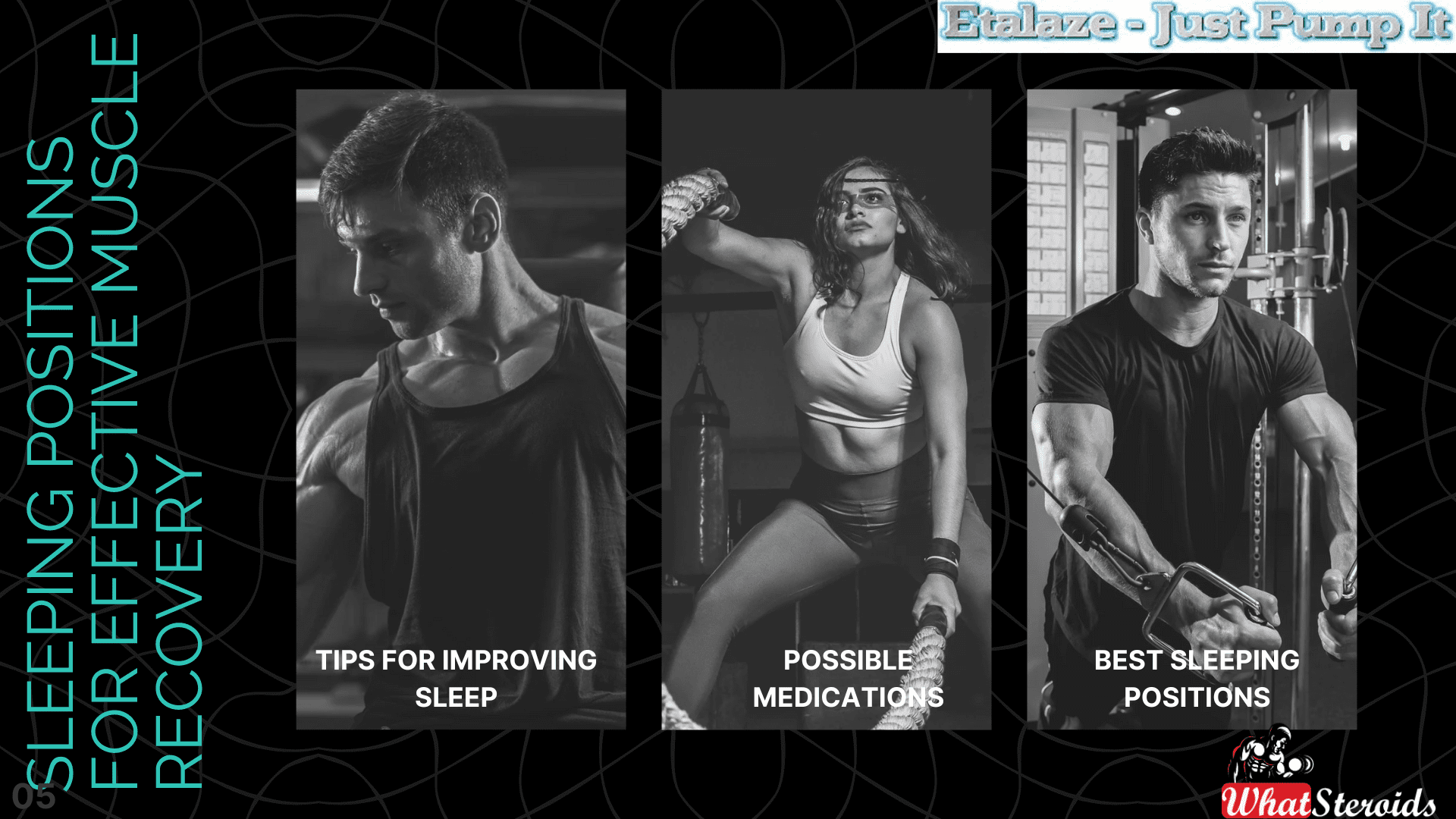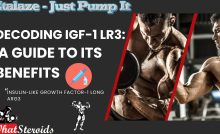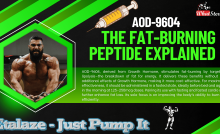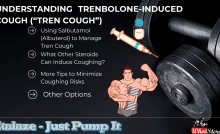Sleeping Positions for Effective Muscle Recovery


Sleeping positions can significantly impact muscle recovery for bodybuilders. Here's how:
1. Blood Flow and Circulation
- Optimal Position: Sleeping on your back with a pillow to support the natural curve of your spine.
- Benefit: This position helps maintain proper alignment, ensuring unobstructed blood flow, which is essential for delivering nutrients and oxygen to muscles, facilitating recovery and growth.
2. Spinal Alignment
- Optimal Position: Sleeping on your back or side with proper pillow support.
- Benefit: Proper spinal alignment reduces strain on muscles and ligaments, preventing aches and promoting overall muscle recovery.
3. Muscle Relaxation
- Optimal Position: Sleeping on your back with arms at your sides or on your stomach with a pillow under your hips.
- Benefit: These positions help muscles relax and reduce tension, which is crucial after intense workouts.
4. Reduction of Inflammation
- Optimal Position: Elevating legs slightly while sleeping on your back.
- Benefit: Elevation can reduce swelling and inflammation in the legs, which is beneficial for muscle recovery.
5. Prevention of Pressure Points
- Optimal Position: Sleeping on your back or switching sides periodically.
- Benefit: Avoiding prolonged pressure on one area prevents discomfort and muscle stiffness after trt bodybuilding.
6. Quality of Sleep
- Optimal Position: A position that ensures you sleep deeply and without interruptions.
- Benefit: Deep, uninterrupted sleep is crucial for the release of growth hormone, which aids in muscle repair and growth.
Best Sleeping Positions for Muscle Recovery
Here are some effective positions for muscle recovery:
- Child’s Pose: Kneel down, sit back on your heels, and stretch your arms forward.
- Downward Dog: Form an inverted V shape with your body, stretching your hamstrings and calves.
- Cobra Stretch: Lie face down, lift your upper body, and arch your back.
- Pigeon Pose: Stretch your hip flexors and glutes by crossing one leg over the other.
- Seated Forward Fold: Sit with legs extended, reach for your toes, and stretch your hamstrings.
- Cat-Cow Stretch: Alternate between arching and rounding your spine on all fours.
- Standing Quadriceps Stretch: Grab your ankle behind you and gently pull to stretch your quads.
- Hamstring Stretch: Sit with one leg extended, bend the other knee, and reach for your toes.
- Butterfly Stretch: Sit with soles of your feet together and gently press your knees toward the floor.
- Hip Flexor Stretch: Lunge forward, keeping your back leg straight, and feel the stretch in your hip flexors.
- Triceps Stretch: Reach one arm overhead and bend at the elbow, gently pulling your elbow with the other hand.
- Standing Calf Stretch: Step one foot back, press your heel into the ground, and lean forward.
- Lying Quad Stretch: Lie on your side, bend your top knee, and grab your ankle to stretch your quads.
- Side Lunge Stretch: Take a wide step to the side, bend one knee, and shift your weight.
- Standing Forward Fold: Bend at the waist, reaching for your toes to stretch your hamstrings and lower back.
- Wall Chest Stretch: Place your forearm against a wall and gently turn your body away after trt bodybuilding.
- Seated Spinal Twist: Sit cross-legged, twist your torso, and hold opposite knees.
- Lizard Pose: Lunge forward and place your hands inside your front foot, stretching your hip flexors.
- Supine Twist: Lie on your back, bend your knees, and drop them to one side while keeping your shoulders on the ground.
- Standing Glute Stretch: Cross one ankle over the opposite knee and gently sit back into a squat.
Tips for Improving Sleep for Muscle Recovery
Here are some tips to improve your sleep position for muscle recovery after trt bodybuilding:
- Back Sleeping: Sleeping on your back is generally recommended. It helps maintain a neutral spine alignment and reduces pressure on joints and muscles.
- Pillow Support: Use a supportive pillow that keeps your head and neck aligned with your spine. This prevents strain on neck muscles.
- Mattress Quality: Invest in a good-quality mattress that provides adequate support. A medium-firm mattress is often ideal for most people.
- Avoid Stomach Sleeping: Sleeping on your stomach can strain your neck and lower back. It also restricts deep breathing.
- Leg Elevation: Elevate your legs slightly by placing a pillow under your knees. This can reduce pressure on the lower back and improve circulation.
- Side Sleeping: If you prefer side sleeping, place a pillow between your knees to align your hips and reduce strain on the lower back.
- Avoid Twisting: Avoid twisting your body while sleeping. Maintain a straight alignment from head to toe.
- Temperature Control: Keep your bedroom cool and comfortable. The right temperature promotes better sleep quality after trt bodybuilding.
- Dark Environment: Use blackout curtains or an eye mask to create a dark sleeping environment. Melatonin production is enhanced in darkness.
- Limit Screen Time: Avoid screens (phones, tablets, TVs) before bedtime. Blue light disrupts your sleep cycle.
Must Read: 5 Best Steroid Cycles For Beginners
Possible Medications to Improve Quality of Sleep for Muscle Recovery
Several medications can improve the quality of sleep, especially for those who have difficulty falling asleep, staying asleep, or experiencing restorative sleep. Here are some commonly used medications:
Prescription Medications
- Benzodiazepines
- Examples: Temazepam (Restoril), Diazepam (Valium)
- Use: Short-term treatment of insomnia and anxiety.
- Caution: Risk of dependence and side effects like drowsiness and memory issues.
- Non-Benzodiazepine Hypnotics (Z-Drugs)
- Examples: Zolpidem (Ambien), Eszopiclone (Lunesta), Zaleplon (Sonata)
- Use: Short-term treatment of insomnia.
- Caution: May cause next-day drowsiness, dizziness, and unusual sleep behaviors.
- Melatonin Receptor Agonists
- Examples: Ramelteon (Rozerem)
- Use: Helps regulate the sleep-wake cycle.
- Caution: Generally well-tolerated with few side effects.
- Orexin Receptor Antagonists
- Examples: Suvorexant (Belsomra)
- Use: Treats insomnia by blocking the activity of orexin, a neurotransmitter involved in wakefulness.
- Caution: Can cause next-day drowsiness.
- Antidepressants
- Examples: Trazodone, Doxepin (Silenor)
- Use: Low doses can be prescribed for insomnia, especially in people with depression.
- Caution: Side effects can include daytime drowsiness and dizziness.
Over-the-Counter (OTC) Medications
- Antihistamines
- Examples: Diphenhydramine (Benadryl), Doxylamine (Unisom)
- Use: Commonly used as sleep aids.
- Caution: Can cause next-day drowsiness, dry mouth, and constipation; not recommended for long-term use.
- Melatonin Supplements
- Use: Helps regulate the sleep-wake cycle, especially useful for jet lag or shift work.
- Caution: Generally well-tolerated, but can cause dizziness, headaches, or nausea in some people.
- Herbal Supplements
- Examples: Valerian root, Chamomile, Lavender
- Use: Natural sleep aids that promote relaxation and sleep.
- Caution: Efficacy varies, and some may interact with other medications.
Note:
- Consult a Healthcare Provider: Always consult with a healthcare provider before starting any medication to ensure it’s appropriate for your specific situation and to avoid potential interactions with other medications or underlying conditions in trt bodybuilding.
- Short-term Use: Many sleep medications are intended for short-term use to avoid dependence and tolerance.
- Lifestyle Modifications: Medications should be complemented with good sleep hygiene practices, such as maintaining a regular sleep schedule, creating a comfortable sleep environment, and avoiding caffeine or electronic screens before bedtime.
Take Away
Recent Posts
Decoding IGF-1 LR3: A Guide to its Benefits
IGF-1 LR3 (Insulin-like Growth Factor-1 Long Arg3) is a synthetic variant of IGF-1, a hormone…
AOD-9604: The Fat-Burning Peptide Explained
AOD-9604, along with the similar HGH Frag 176-191, is a peptide derived from Growth Hormone…
Understanding Trenbolone-Induced Cough (“Tren Cough”)
Trenbolone, a potent anabolic steroid, can sometimes cause “tren cough”—a sudden and intense coughing episode…
Creatine vs Myostatin: An Expert’s Analysis
Myostatin, a protein encoded by the MSTN gene, acts as a regulator of muscle growth.…
Raloxifene (Evista) 101: A Non-Surgical Solution for Gyno
Raloxifene, a selective estrogen receptor modulator (SERM), is one of the most valuable yet less…
Mastering Bodybuilding in 2025: Top Fitness Tips for Success
Bodybuilding is more than just a sport; it's a lifestyle that requires dedication, discipline, and…



